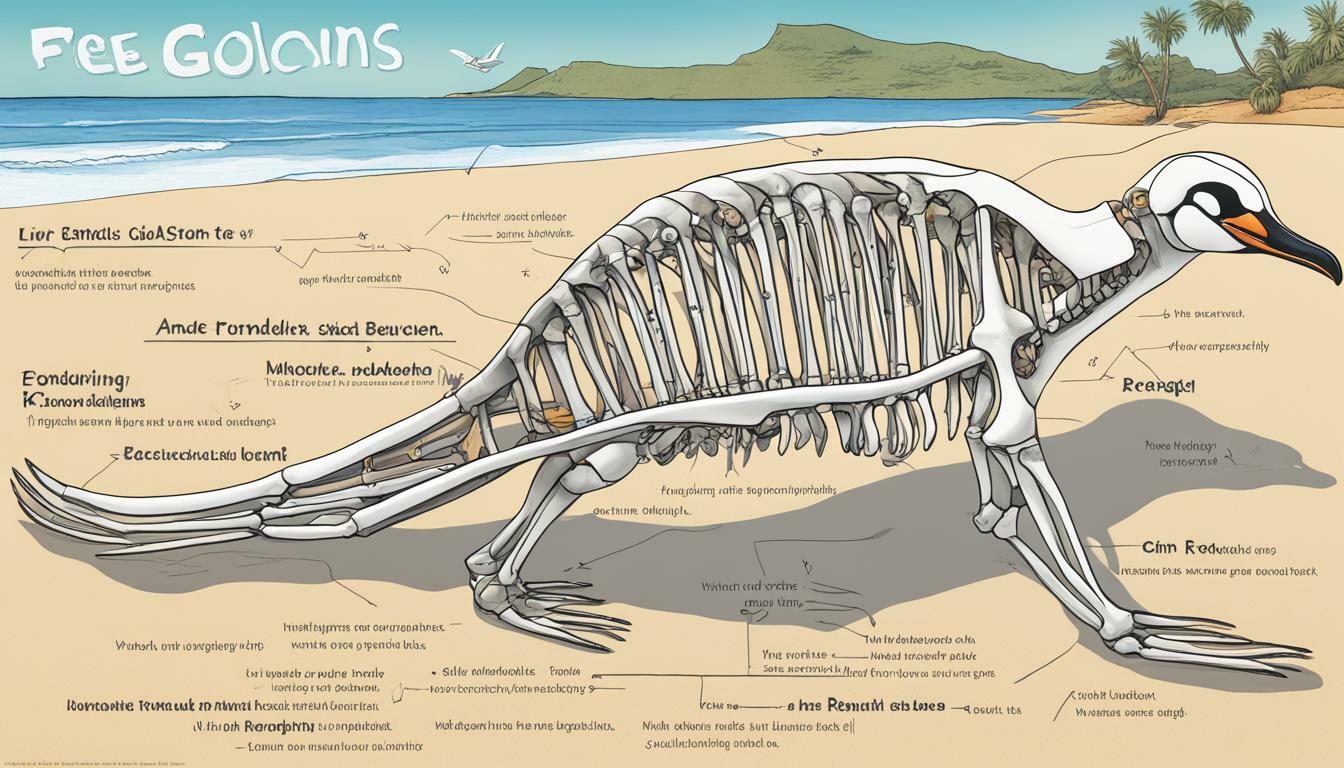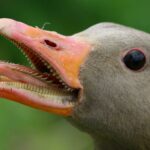Have you ever wondered whether penguins have knees? These fascinating creatures are known for their unique waddling gait and are often depicted standing upright on their hind legs. But what lies beneath the surface of their fluffy feathers? In this article, we will explore the leg structure and anatomy of penguins to reveal the truth about their limb joints.
The penguin leg structure is unlike that of any other bird, and this has led to much speculation about the presence of knee joints. By examining their skeletal system and movement patterns, we will uncover the mysteries behind penguin anatomy and locomotion.
Key Takeaways:
- Penguins have a unique leg structure that sets them apart from other birds.
- Examining their skeletal system and movement patterns can help us understand penguin anatomy and locomotion.
- The question of whether penguins have knees will be answered in this article.
The Penguin’s Leg Structure
Have you ever wondered about the leg structure of penguins? As birds, they have some unique adaptations that differentiate them from other species. In this section, we will explore the leg structure of penguins and determine whether they possess knee joints.
Penguins have a fused ankle and knee joint, which is why you may have heard that they do not have knees in the traditional sense. Their legs are short and stout, with webbed feet that help them propel through the water. Unlike many birds, penguins walk on their heels and toes rather than the middle of their foot. This unique adaptation allows them to maintain stability on slippery surfaces and also reduce heat loss.
The fused ankle and knee joint in penguins is known as a “flexed foot” or “penguin foot.” This joint is highly flexible and allows penguins to tuck their feet close to their body, reducing drag while swimming. However, this flexibility also means that penguin legs are weaker than those of other birds, making them more prone to injury.
So, while penguins do have leg joints that allow for movement and flexibility, they do not have traditional knee joints like humans or other animals. Their unique leg structure is an adaptation that enables them to move efficiently through their environment and survive in harsh conditions.
Penguin Anatomy: Uncovering the Truth
When it comes to understanding whether penguins have knees or not, it’s important to take a closer look at their anatomy and skeletal system. The bones and joints of penguins are unique, as they have adapted to their aquatic environment and the demands of swimming.
Penguins have a fused tibia and fibula that forms a strong and supportive structure, allowing them to stand upright on their feet. Unlike most birds, penguins have short, sturdy legs that are situated at the rear of their bodies, providing better balance and maneuverability in water. In fact, their femur bones have angled heads that point inward, which improves their hydrodynamic shape and boosts swimming efficiency.
But what about knees? Penguins do have joints in their legs, but they are not considered traditional knees. Instead, they have a modified joint that functions similarly to a human knee, providing flexibility and range of motion. This joint is located near the middle of their leg and is often mistaken for a knee. So, while penguins don’t technically have knees, they do have a joint that serves a similar purpose.
Penguin anatomy goes beyond their leg structure, however. Their torso and wings are also uniquely adapted to their aquatic lifestyle. For example, they have solid bones that help them dive and maneuver underwater without floating to the surface. Their wings have evolved into flipper-like structures that enable them to “fly” through the water, propelling themselves with great speed and agility.
The skeletal system of penguins is a testament to their evolutionary adaptations, allowing them to thrive in some of the harshest environments on earth. By understanding their anatomy and leg structure, we can gain a deeper appreciation for these fascinating creatures and their remarkable abilities.
Penguin Movement: Adaptations for Survival
As flightless birds, penguins have evolved unique adaptations that allow them to move in their characteristic waddling gait on land and swim efficiently in the water. These adaptations include streamlined bodies, webbed feet, and stiff, paddle-like wings that aid in buoyancy and steering when swimming.
On land, penguins rely on their strong legs and flat feet to propel themselves forward in a waddling motion. This form of locomotion helps them conserve energy and maintain balance on slippery surfaces such as ice. However, it also limits their speed and agility on land compared to other birds.
When swimming, penguins use their wings as flippers to propel themselves forward and steer in the water. They can swim at speeds of up to 22 mph in short bursts, allowing them to efficiently hunt for fish and other prey. Their dense bones and air sacs also aid in buoyancy and diving to great depths, with some penguins able to dive over 500 feet deep.
These adaptations have allowed penguins to thrive in their harsh and varied environments, from the freezing Antarctic to the warmer climates of South Africa and Australia. Their unique locomotion, paired with their social behavior and striking appearance, has also made them a beloved and intriguing species for researchers and wildlife enthusiasts alike.
The Truth About Penguin Knees
After examining the leg structure and anatomy of penguins, you may be wondering: do they actually have knees? The answer is complex.
Penguins do have knee joints, but they are not visible like human knees. Instead, their knee joint is located higher up on their body, close to their torso. This joint is covered by feathers, making it difficult to see.
The unique leg structure of penguins allows for efficient swimming, diving, and waddling on land. Their bones are dense and heavy, which helps them handle the pressure of deep dives and reduces buoyancy. Their legs also point backwards, which aids in swimming and makes walking on land more awkward but efficient.
Additionally, penguins have evolved several adaptations to compensate for their leg structure and allow for efficient movement. They use their flippers to swim, while their feet and legs are used for steering and propulsion. When waddling on land, they sway their bodies back and forth for balance and take short, quick steps to conserve energy.
So, to answer the question: do penguins have knees? Yes, they do, but their unique leg structure and adaptations make it difficult to see them. Regardless of the knee joint’s visibility, penguins continue to fascinate and inspire awe with their remarkable abilities.
Conclusion
After exploring the fascinating world of penguin leg anatomy, we have finally uncovered the truth about whether they have knees. While penguins do not have traditional knees, they do possess unique leg joints that allow them to move with speed and agility both on land and in water.
Through their adaptations, penguins have mastered various forms of movement, including waddling, sliding, diving, and swimming. Their leg structure and anatomy enable them to navigate different terrains and catch prey with precision.
In conclusion, while penguins may not have knees in the traditional sense, their leg structure and anatomy are a testament to the incredible diversity and complexity of the natural world.
Can Crows Remember Penguin Faces?
Studies have shown that crows’ face recognition abilities are astonishing. As researchers discovered, crows can remember and recognize penguin faces even after not seeing them for over a year. This ability showcases the impressive cognitive skills of these intelligent birds, raising intriguing questions about the complexity of their social interactions and memory capabilities.
FAQ
Q: Do penguins have knees?
A: While penguins do have leg joints, they do not have traditional knees like humans and other mammals. The placement of their leg bones and the way they are structured gives the appearance of knees, but their knees are actually located higher up in their bodies, closer to their abdomen.
Q: How do penguins walk without knees?
A: Penguins have adapted to their unique leg structure by waddling instead of walking. Their short, sturdy legs and webbed feet allow them to efficiently move across land and ice without the need for knees. They rely on their flippers and a combination of sliding and hopping motions to get around.
Q: Can penguins bend their legs?
A: Yes, penguins can bend their legs at their joints. While they may not have knees in the traditional sense, they have joints that allow them to flex their legs and adjust their posture. This flexibility is important for their various movements, such as swimming, sliding, and standing upright.
Q: Why don’t penguins need knees?
A: Penguins’ leg structure and lack of knees are adaptations that have evolved to suit their aquatic lifestyle. By having their leg bones positioned differently and relying on other joints for mobility, penguins are better equipped for swimming and diving in the water, where their kneeless legs provide less resistance and allow for smoother movement.
Q: Do all birds have knees?
A: No, not all birds have knees in the same way that humans and mammals do. Birds, including penguins, have modified leg structures that vary among species. Some birds, like penguins, have leg joints that are positioned higher up, while others have knees that are more visible. The unique adaptations in bird leg structure enable them to meet the specific demands of their habitats and locomotion.











